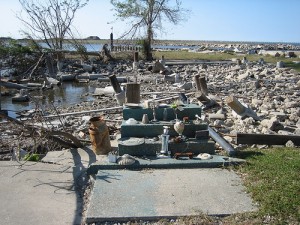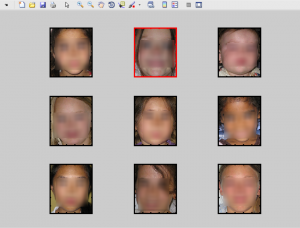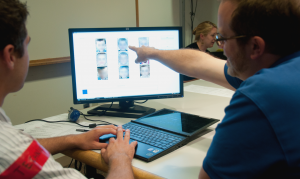
Five thousand children were separated from their families in the wake of Hurricane Katrina. With the REUNITE system, Sarita Chung wants to bring families back together more quickly following a disaster. (infrogmation/Flickr)
Once we’ve checked in at the disaster aid center, a social worker leads my wife and me into a room and warmly introduces us to a pair of technicians seated at computers. After asking us each some questions, the techs enter some commands on their keyboards and pictures of children start appearing on the screens before us, nine at a time. Our job: to find and be reunited with our boys.
Luckily, this is only a drill. But in the wake of a disaster like last month’s tornadoes in Western Massachusetts, reunifying separated children and parents is a real and urgent concern.
“Five thousand children were separated from their families after Hurricane Katrina, some by hundreds of miles once the evacuations started,” says Sarita Chung of the Division of Emergency Medicine at Children’s Hospital Boston. “And the 2010 Haiti earthquake put more than a million children at risk.” Children who cannot speak for themselves because they are too young or have developmental delays, or who are injured and have to be rushed to emergency rooms, are at particular risk of being separated from their families in the chaos following a hurricane, earthquake or other disaster.
For three years, Chung and her colleagues have been working on a family reunification system they call REUNITE. Backed by a grant from the federal Health Resources and Services Administration’s Emergency Medical Services for Children program, it’s not the first such system – a number of federal, local and nongovernmental disaster management and aid agencies have systems in place – but in reviewing the alternatives, Chung thinks it can be done better when it comes to children.
“The Federal Emergency Management Agency has good systems, but you can only access them after a federal disaster declaration,” she says. “New York State uses a photo and fingerprint registry maintained by law enforcement, but not everyone wants to have their child on file with the police. Most of the local systems are fragmented and better suited to forensic identification. And none of them address the privacy concerns that we face at a hospital.”

One of the REUNITE photo screens. Parents choose pictures (not blurred in the real system) of children with features most closely resembling their own child's, narrowing down the pool of children to pick from. (Courtesy Sarita Chung)
REUNITE works like this: Emergency workers bring lost children who do not need, or have already received, medical treatment to a “pediatric safe zone” at a hospital, shelter or similar disaster aid location. A photo of each child is loaded into the system, which automatically extracts and records physical features like sex, age, and eye, hair and skin color.
Parents seeking their children are asked for details on the child’s appearance and then review photos of children matching their descriptions. “We present several photos at a time and ask them to select those of children whose features most resemble their own child’s,” Chung explains. “So a parent may choose a picture because the child has the same shaped chin or nose or eyes as their son or daughter.”
With each choice, the system narrows down the pool of children, ultimately ending up with the child the parent is looking for. From there, it alerts social workers that an identification has been made, setting into motion a protocol to reunite the family.
“Because of the risk of child abduction or exploitation after a disaster, we want to avoid situations where someone claims to be a child’s parent when they are really not,” says Chung. “So when a parent does ID a child, we ask them to answer questions that we’ve already asked the children, like the name of the family pet.”
Chung’s team recently partnered with several departments from across Children’s – Child Life, Emergency Management, Psychiatry, Social Work and Volunteer Services – and invited local and state emergency management agencies to hold a REUNITE drill. The scenario: the aftermath of a tornado striking several school buildings during classroom hours.

Me at the REUNITE drill. It only took about 10 or 15 minutes for me to find both of my boys in the system. (Courtesy Steve Coldwell)
And so we come back to my wife and me, sitting in front of a pair of computer screens in a conference room. We’ve provided basic physical descriptions of our two boys, and now we’re looking for them among the 1,200 photos – 134 pages of images – selecting one with the right hair color, another with the same eyes, a third with similar cheekbones and so on.
After 20 pages of pictures – about 5 minutes of searching – I find my 3-year-old, and start over hunting for my 7-year-old. Another 19 pages, and there he is.
My wife has similar success. “It got harder as time went on, though,” she mentions later. “Even though I knew it was a drill, I definitely started to feel anxious about not finding them, or about missing them on one of the screens.”
Anticipating such anxiety, Chung’s protocol includes social workers in the room to comfort and support parents and help them continue their search.
The next day, I ask Chung how she thought the drill went. “It was undoubtedly a success,” she replies. “The drill allowed us to test a process using advanced technology to facilitate faster family reunifications.
“But in addition to the technological aspects of the drill,” she adds, “it is important to understand that the essence of the success lies in multidisciplinary collaboration of related departments. It was the coordinated efforts of the departments of Emergency Management, Social Work, Child Life, Psychiatry and the Volunteer Office that really made this work.”






